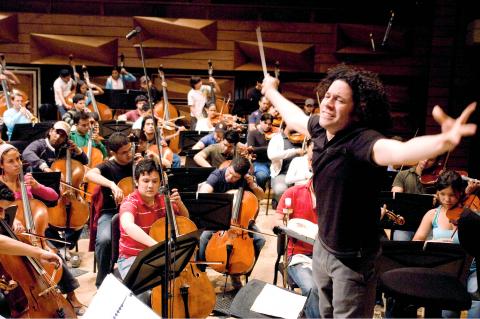Coolness might rest in the eye of the beholder, but an undeniable consensus coalesces around certain classic notions of what is cool and what is not.
James Dean and George Clooney? A 1955 Thunderbird coupe and James Bond’s 1964 Aston Martin DB5? Billie Holiday, Bruce Springsteen, Jay-Z and certain parts of Brooklyn? All totally cool.
But classical music? Not so much.

Photo: Bloomberg
Somehow, the world of opera, symphony orchestras and chamber music has come to be seen by much of the general public as staid, stodgy and just plain passe.
While paparazzi stake out the openings of celebrity visual artists such as Damien Hirst or the premiere of an Angelina Jolie film, and publications of every kind fall over themselves to land an interview with Lady Gaga, most general media all but ignore classical music.
In some ways, its reputation as demode is deserved. Parts of the field have fallen into a rut, unenthusiastically repeating the same well-worn favorites by Mozart and Brahms in the same two-hour formats they have employed for decades.

Photo: Bloomberg
But on the other hand, classical music, a centuries-old form that can soaringly celebrate the human spirit and piercingly evoke life’s ugliness, does not always get a fighting chance.
A culture that thrives on three-minute pop songs and instant downloads doesn’t have much time for a 20-minute Beethoven string quartet that needs contemplation and several hearings to be fully appreciated
What is clear is that if classical music is to be anything other than a cultural relic at the fringes of public consciousness, it is going to have to up its coolness quotient. Let’s face it, in today’s image-obsessed culture, perceptions matter more than ever. The field needs its Miles Davis. Or at least another Leonard Bernstein.
And fast.
“How people perceive the music before they get into the room has a huge impact on whether or not they will go to the concert,” said Gabriel Kahane, a boundary-blurring New York composer and singer who gives Schumann art songs a piano-man flair. “Then once they’re in there, it’s just a question of quality and not really a question of genre.”
But the stakes go beyond just ticket sales. How the field is viewed also has a big impact on its ability to attract talent and keep singers and musicians from defecting to other potentially more alluring genres. It needs a judicious dose of glamour and celebrity appeal.
“Why would anyone want to become an opera singer if they thought it was a dead end as an art form?” said Peter Gelb, general manager of New York’s Metropolitan Opera. “We need to demonstrate not only to a new public that the arts are something that they would want to come and participate in, we need to demonstrate it to a future talent pool.”
To use today’s marketing parlance, classical music needs to rebrand itself. The moniker, “classical music,” simply does not have the snap and pop of active, evocative terms like “jazz,” “rap” or “rock.”
So what to call it? A few names have been floated, and all of them have obvious flaws. They include “serious music” (All the other genres are frivolous?), “art music” (Could that be any more pedantic?) or “concert music” (Isn’t most music performed in concerts?).
But any revamped name needs the revitalized product to back it up. Classical music has to be entrepreneurial and take more risks. That means everything from offering new, genre-bending music to artists and ensembles stepping outside traditional concert halls and playing in rock clubs and coffee shops.
Equally important is finding new ways to market classical music, not being afraid to step down from the field’s lofty perch and get out there, compete and really woo audiences, using Facebook, YouTube and the host of other new technologies.
The challenges are huge. Classical music is a centuries-old form steeped in tradition, and change doesn’t come easily. Some people in the field are uncomfortable with even the mention of coolness and classical music in the same sentence.
When this subject was broached with famed violinist Hilary Hahn in an e-mail, she replied: “Is this middle school? I’m not sure pointedly trying to be cool helps anyone or anything.”
Her concern is understandable. Too often in our culture, making something more accessible means dumbing it down.
It is easy to worry that classical music will get engulfed in the anti-intellectualism that seems to be gathering strength, as evidenced by politicians who delight in broken grammar and made-up words like “refudiate,” and a steady decline in reading, as a 2007 National Endowment for the Arts study documented.
But changing classical music doesn’t have to mean cheapening it. The unlikely world of television offers one possible template.
That “vast wasteland,” as former Federal Communications Commission chairman Newton Minow famously labeled it in 1961, has become home to some of the most compelling storytelling anywhere.
Thought-provoking, issues-oriented programs such as Deadwood, Mad Men and The Wire have managed to achieve intelligence and sophistication in one of the most democratic and acceptable entertainment vehicles around.
In short, art and accessibility can work together.
For an ideal role model, the classical music world need only peer into its own recent past at the towering figure of Leonard Bernstein (1918-1990), America’s most influential classical musician of the 20th century.
Bernstein was an acclaimed conductor and pianist as well as a composer who was at home writing for Broadway as well as the concert hall. He brought visible intensity and passion to everything he did — never hesitating to leap up from the podium to drive home a pivotal point in a score.
He was a master communicator and teacher who was comfortable in virtually any setting and, as he demonstrated with his 53 televised Young People’s Concerts, had a knack for making classical music understandable, approachable and even fun.
Perhaps most important, he didn’t see classical music as merely entertainment but also as a larger force for transformation and healing, as he made clear with his December 1989 concert in Germany celebrating the fall of the Berlin Wall.
Through the sheer force of his personality, the breadth of his accomplishments and his obvious sense of style, Bernstein transcended classical music and became a widely recognized figure in culture at large.
Still a force to be reckoned with 20 years after his death, he was a true superstar with intellectual heft and an enduring, still-evolving legacy. Think we’ll be saying that about Lady Gaga and Brangelina 50 years from now?
Some of his dozens of proteges, like internationally known conductors Michael Tilson Thomas and Marin Alsop, have worked hard to carry on his tradition. But so far, at least, they have not achieved the maestro’s stature.
The latest heir to the Bernstein legacy and potentially classical music’s next breakout star — Gustavo Dudamel — comes not from the US but from Venezuela, a country with an extraordinary network of government-supported youth orchestras.
With a beaming smile, a flying mass of curly hair and an electrifying stage presence, the 29-year-old has captivated Los Angeles Philharmonic audiences — with every concert he has conducted in his first two seasons as music director sold out. He is high culture’s Justin Bieber.
The Philharmonic obviously sought to capitalize on Dudamel’s youthful spirit and the buzz already surrounding him when it chose him as its new music director, and it has been careful to curry his image but not oversell him.
“Gustavo was a really hot property and, so, everyone had this inclination that he was this rock star,” said Shana Mathur, vice president of marketing and communications. “But if you market him like a rock star, is that going to burn out really quickly, especially with the true classical music lovers? Is that too much hype? We really had to find a balance between what would excite new people and also what be authentic to who he is.”
Capitalizing on Los Angeles’ large Latino population, the orchestra introduced Dudamel with it called its Pasion marketing campaign, an effort keyed to Spanish words like electrico and vibrante that evoked the conductor’s dynamic persona and were decipherable by English speakers.
The Los Angeles Philharmonic also launched several popular smartphone apps, including a conducting game based on Dudamel leading works by Mahler and Berlioz, and, next month, it is rolling out a series of live HD broadcasts of the maestro and orchestra to movie theaters nationwide.
The big question is: How far can the young conductor go, especially in the face of media world that has all but turned its back on classical music? Does he have enough appeal to transcend the confines of the classical world and really become a breakout star like Pavarotti or even Clooney?
Inherent in any discussion of coolness and classical music is a need to manage expectations.
The form is probably never going to draw arena-size audiences like U2 or Madonna, but it can remake its image, broaden its reach and become more relevant to everyday listeners.
Classical as cool as Sinatra? Imagine that.

That US assistance was a model for Taiwan’s spectacular development success was early recognized by policymakers and analysts. In a report to the US Congress for the fiscal year 1962, former President John F. Kennedy noted Taiwan’s “rapid economic growth,” was “producing a substantial net gain in living.” Kennedy had a stake in Taiwan’s achievements and the US’ official development assistance (ODA) in general: In September 1961, his entreaty to make the 1960s a “decade of development,” and an accompanying proposal for dedicated legislation to this end, had been formalized by congressional passage of the Foreign Assistance Act. Two

Despite the intense sunshine, we were hardly breaking a sweat as we cruised along the flat, dedicated bike lane, well protected from the heat by a canopy of trees. The electric assist on the bikes likely made a difference, too. Far removed from the bustle and noise of the Taichung traffic, we admired the serene rural scenery, making our way over rivers, alongside rice paddies and through pear orchards. Our route for the day covered two bike paths that connect in Fengyuan District (豐原) and are best done together. The Hou-Feng Bike Path (后豐鐵馬道) runs southward from Houli District (后里) while the

On March 13 President William Lai (賴清德) gave a national security speech noting the 20th year since the passing of China’s Anti-Secession Law (反分裂國家法) in March 2005 that laid the legal groundwork for an invasion of Taiwan. That law, and other subsequent ones, are merely political theater created by the Chinese Communist Party (CCP) to have something to point to so they can claim “we have to do it, it is the law.” The president’s speech was somber and said: “By its actions, China already satisfies the definition of a ‘foreign hostile force’ as provided in the Anti-Infiltration Act, which unlike

Mirror mirror on the wall, what’s the fairest Disney live-action remake of them all? Wait, mirror. Hold on a second. Maybe choosing from the likes of Alice in Wonderland (2010), Mulan (2020) and The Lion King (2019) isn’t such a good idea. Mirror, on second thought, what’s on Netflix? Even the most devoted fans would have to acknowledge that these have not been the most illustrious illustrations of Disney magic. At their best (Pete’s Dragon? Cinderella?) they breathe life into old classics that could use a little updating. At their worst, well, blue Will Smith. Given the rapacious rate of remakes in modern